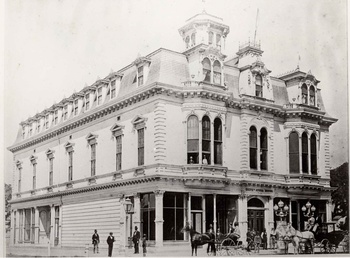Dietz Opera House (c.1874–1911), Oakland’s first theatre, was located on the northeast corner of Webster Street and 12th Street (aka “Central Avenue” for a few years). The c.1860 edifice had been built as Brayton Hall, once a part of the University of California before that institution moved to Berkeley.
Alfred C. Dietz purchased the property c. 1874–5 from the University. (Theatres of Oakland says the theatre began in 1873, but a September 1874 auction of the property by the U.C. referred to it as Brayton Hall, and a newspaper article says Dietz bought it in 1875 5. In any event, sources agree it was the first theatre in Oakland.)
The opera house was located in the second floor, while the downstairs housed a saloon and a wholesale plumbing supply.
With a seating capacity of 700, the Dietz Opera House featured such performances as “The renowned historical celebrities Buffalo Bill and Captain Jack in the realistic Western drama, written especially for Buffalo Bill, in 5 acts, entitled Life on the Border …” 1 which played for one night only, Wednesday, June 13th, 1877, and well-known stage actors such as Sarah Bernhardt and Adelaide Neilson.
Members of First Methodist Church used the theater for a church (1875-1876) while their new building was constructed at 14th and Clay Streets. 6
In 1884-’85 the Dietz Opera House was listed as having a seating capacity of 900, with a nightly rental fee of $50 (three nights for $125), which included the license. The stage size was 27′×45′ with full stock scenery. For advertising purposes: bill poster: Stilwell Bros.; daily newspapers: Oakland Tribune and Times. Suggested hotels in the area of the opera house were the Galindo (rates $2 to $2.50), Tubbs (rates $2.50), Windsor, Grand Central, Newland, Centennial, Chase, Roberts and Kohler.2
Apparently a change in the city charter around 1889 put the legality of the saloon into question:
An officer yesterday served a notice on A. C. Dietz to shut up his ‘’Opera Saloon” or suffer arrest. Dietz replied: “This city can go to ____. I have a license that does not expire until the 7th of May, and I propose to keep open in spite of Hackett and the Council.” Last evening Mr. Dietz, who is a prominent San Francisco business man, was led a captive to the City Prison. Bail was furnished. Mr. Dietz may test the validity of the new municipal charter. 8
This apparently didn't go well, as a judge found him guilty of selling liquor without a license. Judge Laidlaw concluded that while the action of the Council "may have been harsh and arbitrary, yet it was valid." 10
At some point in the Dietz Opera House’s history, Jack London delivered a lecture on Socialism there. 3 The socialist party had its campaign headquarters there c.1911. 7
The theater, along with the rest of the former UC block, was sold by Dietz in 1903 5. The theater ceased operations in 1905. On May 1, 1911 the wooden Dietz Opera House burned to the ground (perhap an attempt to dislodge the socialists?), and was later demolished. Other buildings in the block were also destroyed or badly damaged in the blaze, including the old Dewey Theatre, and the four-story brick Polytechnic College. 4
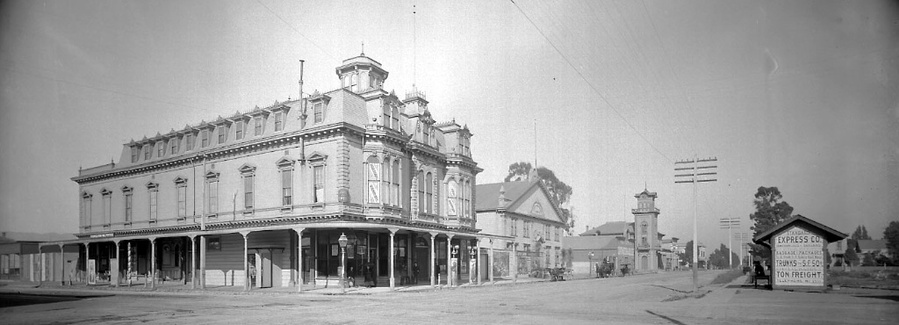 Dietz Opera House at Webster (at left) & 12th (background), looking NE
Dietz Opera House at Webster (at left) & 12th (background), looking NE
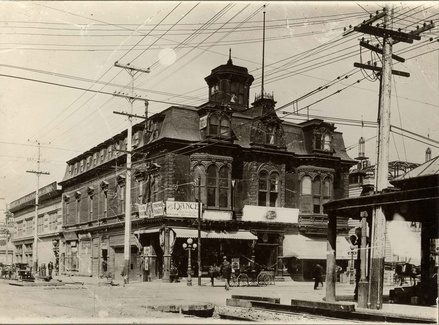 Dietz Opera House
Dietz Opera House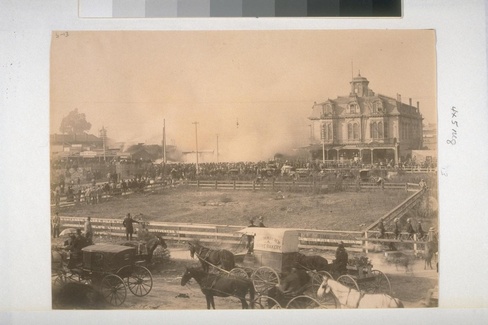 Photographed by Frank B. Rodolph
Photographed by Frank B. Rodolph
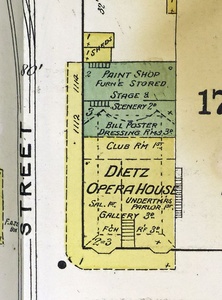 1889 Sanborn excerpt
1889 Sanborn excerpt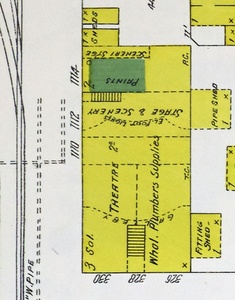 1903 Sanborn excerpt
1903 Sanborn excerpt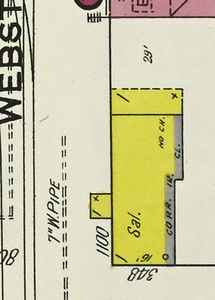 1911 Sanborn excerpt
1911 Sanborn excerpt
Links and References
- Dietz Opera House Cinema Tour
-
The Dramatic Year Book for … 1891 Charles Smith Cheltnam
-
Theatres of Oakland Arcadia Publishing by Jack Tillmany and Jennifer Dowling
-
Big Blaze Causes Ruin Oakland Tribune May 1, 1911
-
Historic Site is Deeded Away San Francisco Call October 9, 1903
- A Steeple Among the Oaks by Albert E. Norman
- Fire is Last Act at Old Theater San Francisco Call May 2, 1911
- Eastern Shore Daily Alta California April 11, 1889
- INVESTIGATING SALOONS San Francisco Chronicle Oct 18, 1889
- May Revoke a License Sacramento Daily Union May 10, 1889
- Used with permission by UC Berkeley, Bancroft Library
Was it Brayton Hall?
Various sources 7 say the Dietz Opera House (D'OH!) was Brayton Hall on the University of California campus. IIRC there is at least one reference saying it was moved on the lot, too. While there is a resemblance, Dietz was a larger building and had 3 bays on the front. Even allowing for an addition, the basic layout of the building seems wrong.
Discuss :-) Please add evidence for either supposition you find.
-
Mike here. My doubt isn’t the claim that DOH was the former Brayton Hall (if contemporary sources said so, well, they ought to know) but that the building we’re labeling “Brayton Hall” (the one with ~20 guys and boneshaker boy lollygagging out front) may in fact have been another, similarly styled (Second Empire was THE thing c. 1860–80), but smaller (and maybe older) building. What is our evidence to connect that name to that building?
- Finally, thank you guys for caring. I’m fairly confident we’re the only ones ever to sweat this level of detail, making this whole endeavor extra cool! How many can fit on the head of a pin …?!
-
Dennis Evanosky labels the same building that we have in the UC entry (though different picture of it) Brayton Hall in Mountain View Cemetery. (The Braytons were involved in UC and MVC.) -Gene
-
Also, the Braytons had built a commercial “block” only a (city) block or two away. (Didn’t they also live up in that murky Piedmont/Oakland area we’re trying to research – you know, near Monte Cresta/Kelton Ct.?)
-
While the fronts are different, they have a lot of similar details, like the faux stonework trim at the corners and the decorative rafter tails or whatever. More pictures of Brayton Hall might help dispel this doubt. -Gene
- for “might” I’d substitute “are needed to” – (Come on, JL, I have a feeling this will be your thing!)
-
Mike, thanks for your faith in me! Found the following fascinating information that could be used on several different Oakland Wiki entries ... According to Pacific Education Journal, Volumes 1-2: "... Clinton Day, the well-known architect, and Charles A. Wetmore, Chief Executive Officer of the State Viticultural Commission, made up the class of 1868; and of the four who graduated in 1860, E. T. Fowler, now Principal of the Prescott School, was one. The management of the College School was placed almost entirely in the hands of Dr. Brayton. The attendance was good, and the accommodations small. There was no money on hand to build new schoolrooms. Dr. Brayton advanced the money and went ahead with the work. The building which now forms the basis of St. Paul's Episcopal Church had been erected on the block with the original school building. This was moved over on the south side of Twelfth street, near Webster, and the building known as Brayton Hall was erected. This building has since been moved and remodeled, and is now Dietz Opera House. The dining hall building was also built. It afterwards stood at the corner of Broadway and Lover's alley (Fourteenth street), and was recently purchased by Dr. E. H. Pardee, and moved on his San Pablo avenue property. It is known as the Mansion House. The "Spanish Building," erected at about the same time, was moved to the northeast corner of Webster and Eleventh streets, became Dr. Merritt's Great Western Hotel, and was burned down during the Grand Central fire. The tankhouse now does duty as a Chinese laundry, on Delger street, near Telegraph avenue. During this time there was also erected the main College building, now located at the northeast corner of Twelfth and Harrison streets, and occupied by the Dexter Livery Stable and the Acme Athletic clubrooms. The money expended in making these improvements was furnished in large part by Dr. Brayton, and he soon came to have a sort of controlling interest in the entire property of the College and school in Oakland. The College had acquired, however, some 100 acres of land in Berkeley, which the Trustees expected would ultimately become the College site."
- Whoa … jackpot … go JL! The above is a trove of new puzzle pieces. We have photos of the “Mansion House” as well as the St. Paul’s Church (the one near the College, not today’s brick one by Fairyland). The above quote suggests that "the original school building” and "Brayton Hall” were separate buildings, and my gut tells me the photo with the 20 dudes in front was probably of the former – meaning we so far lack any photos of the latter and (gasp) Dennis Evanovsky might be mistaken! You can see how this rabbit hole just explodes in like 50 directions once we get down this far …! But this is a really neat story at base, because it shows how sort of unpredictable and shaky the whole College of California endeavor was. Durant had the passion, Brayton the money, and almost nobody else gave a whit. Yet in just a few years they somehow managed to kindle an enduring institution which survives today. Their perseverance and luck paid off even if the benefits were snatched from Oakland all too soon. (Hey, anybody want to imagine an alternate history where the university had stayed and grown? Downtown Oakland today might resemble New Haven or Cambridge … hmm …)
-
While the fronts are different, they have a lot of similar details, like the faux stonework trim at the corners and the decorative rafter tails or whatever. More pictures of Brayton Hall might help dispel this doubt. -Gene
-
Also, the Braytons had built a commercial “block” only a (city) block or two away. (Didn’t they also live up in that murky Piedmont/Oakland area we’re trying to research – you know, near Monte Cresta/Kelton Ct.?)
- Dunno if it was Brayton Hall, but it WAS the Grand Saloon. 9


